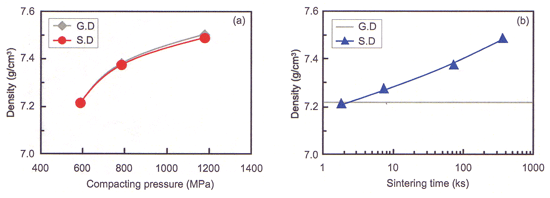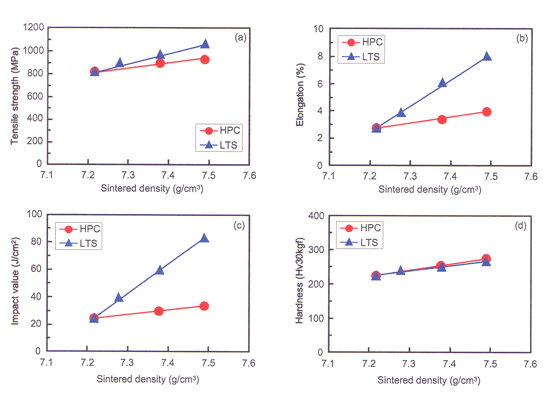PM2012 World PM Congress: Novel routes to high density ferrous powder metallurgy compacts
High density compaction method for soft magnetic composites (SMCs)
Kazuhiro Hasegawa and his colleagues at Aida Engineering Ltd in Sagamihara, Kanagawa, described a two-step compaction process used to produce iron powder compacts for soft magnetic cores having green densities in excess of 7.7 g/cm³. The authors used Somalloy 700 SMC grade iron powder produced by Höganäs AB, where each powder particle is coated with an insulating layer, mixed with 0.4 wt% Kenolube pressing lubricant.
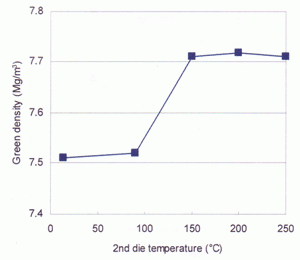
Amount of lubricant 0.4 wt%
1st compacting pressure 980 MPa
2nd compacting pressure 980 MPa
Clearance 0.2mm
(Pre-heating temperature of the 1st green compact
is the same as the 2nd die temperature)
Fig. 1 Relationship between 2nd compaction die
temperature and green density [1]
The powder mixture was compacted into ring shaped compacts at a high compacting pressure of 980 MPa followed by pre-heating the compacts to 150°C. The heated compacts were subject to a second ‘warm pressing’ step also at 980 MPA in a die heated to the same temperature to achieve a green density of not less than 7.7 g/cm³. The second die for warm pressing has a clearance of 0.2 mm to allow for easy loading of the compact. The compacts are finally heat treated at 520°C for 10 min in air.
As can be seen in Fig. 1 the temperature of the second die and the pre-heating of the compact is critical to the increased density achieved in the second warm pressing. This is due to the pressing lubricant in the 1st pressed compact melting during pre-heating above 130°C with the liquid phase reducing frictional slip resistance between the powder particles during warm pressing, and thereby helping the SMC iron powder particles to fill in the pores remaining in the compact after first compaction.
Additionally, the molten lubricant which is exuded from within the compact during pre-heating to 150°C creates a lubricating film on the surface of the compact for die wall lubrication, whilst at the same time reducing the total wt% of lubricant in the compact to as little as 0.1%. Hence the sharp increase in green density in the second warm pressing at 150°C. The 0.2 mm die clearance in the warm pressing step was critical in allowing powder particle sliding and to produce SMC compacts without cracks (Fig. 2).
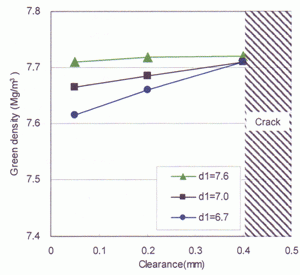
2nd die temperature 150°C
Amount of lubricant 0.1 wt%
2nd compacting pressure 980 MPa
(Pre-heating temperature of the 1st green compact
is the same as the 2nd die temperature)
Fig. 2 Relationship between die clearance and green
density in second pressing step. (d1: green density
after 1st compaction)
The researchers compared the properties of the new two-step method with the conventional method of single pressing at 980 MPa of SMC powders containing 0.4 wt% lubricant at room temperature to reach a green density of 7.51 g/cm³. It was found that the higher density using the newly developed two step compaction method increased the radial crushing strength and magnetic flux density.
Resistivity was increased by about 5 times compared with the single compaction step conventional method which the authors state is an indication that there was no detachment of or damage to the insulating film on each iron powder particle during the first or second pressing stages (Table 1).
The researchers also used Somaloy 110i SMC iron powders, amorphous powders and Fe-6.5%Si to produce magnetic cores by the two-step compaction method and compared the densities achieved with the conventional single pressed method. In all cases increase in green densities was achieved along with improved magnetic properties. Somaloy 110i is a finer coated SMC iron powder produced by Höganäs AB and has been optimised for higher frequencies applications ranging from 10 to 100 kHz, such as inductive components in boost converters for electric and hybrid electric vehicles.

Table 1 Mechanical and magnetic properties of SMC magnetic core ring samples (heat treated at 520°C) [1]
Influence of long time sintering on density of Fe-Mn-Si-C steels
An alternative approach to achieving high density in ferrous PM compacts is to combine high pressure compaction (HPC) with long time sintering (LTS). Toshitake Miyake and his colleagues at the Toyota Central R&D Laboratories Inc., Nagakute, Aichi, took this approach for an Fe-Mn-Si-C Powder Metallurgy steel having a final sintered density of 7.5 g/cm³ . The authors stated that the new PM ferrous material is intended as an alternative material to the commonly used but difficult to recycle PM Fe-Cu-C alloys.
The authors used a Höganäs ASC100.29 water atomized iron powder mixed with 2wt% of a prototype fine (D50:1.1 µm) Fe-Mn-Si-C powder (designated FeMS), and 0.8wt% natural graphite powder. The average composition by wt% of the mixed powder was Fe-1.32%Mn-0.4%Si-0.82%C. High pressure warm compaction (HPC) up to 1176 MPa with die wall lubrication (lithium stearate) was used to produce cylindrical specimens having a green density of 7.2 g/cm³. The green compacts were sintered in pure nitrogen at 1423K for up to 360 ks.
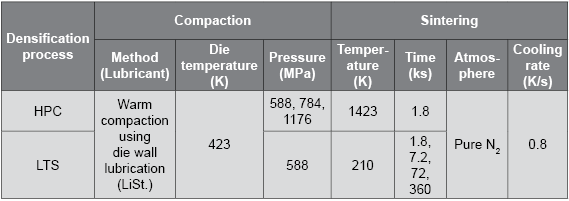
Table 2 Compaction and sintering conditions used to produce the high density Fe-Mn-Si-C sintered alloy [2]
Compaction and sintering conditions are shown in Table 2, and Fig. 3 shows the influence of HPC and LTS on green and sintered densities which reached 7.5 g/cm³ when sintering time was 360ks after HPC. The increased density was attributed to shrinkage of the compacts during LTS of around 1% in the diametrical direction and around 1.3% in thickness direction.
There was however a significant increase in the mechanical properties of the high density PM Fe-Mn-Si-C steels after HPC and LTS with particularly good elongation and impact strength values at 7.5 g/cm³ (Fig. 4). A key reason for the improvement in properties is the change in pore morphology brought about through LTS. The authors stated the maximum pore length decreased with increasing both the compacting pressure and the sintering time, and the spheroidization of the pores increased markedly with increasing sintering time giving the much improved elongation and impact values.
The microstructure in the sintered Fe-Mn-Si-C specimens consisted mainly pearlite independent of compacting pressure or sintering time, but the distribution of Mn and Si was more homogeneous after LTS. However, the homogeneous microstructure was considered to have only a slight effect on mechanical properties.
Figure references
[1] ‘Development of High Density Compaction Method’ by K Hasegawa, Y Hirai, S Morinaga, Aida Engineering Ltd, Kanagawa, Japan. Presented at the PM2012 World PM Congress, Yokohama, October 15-18, and published in the Congress Proceedings by JPMA/JSP&PM, Japan
[2] ‘Influence of Densification Processes on Microstructure and Mechanical Properties of Fe-Mn-Si-C Sintered Steels’ by T. Miyake, N Matsumoto and M Kondoh, Toyota Central R&D Laboratories Inc., Nagakute, Aichi, Japan. Presented at the PM2012 World PM Congress, Yokohama, October 15-18, and published in the Congress Proceedings by JPMA/JSP&PM, Japan
PM2012 World Congress Proceedings
Papers presented at the PM2012 World Congress will be published by the JPMA/JSP&PM in the Congress Proceedings, available in early 2013. Further information will be posted on the conference website.
News | Articles | Market reviews | Search directory | Subscribe to e-newsletter



